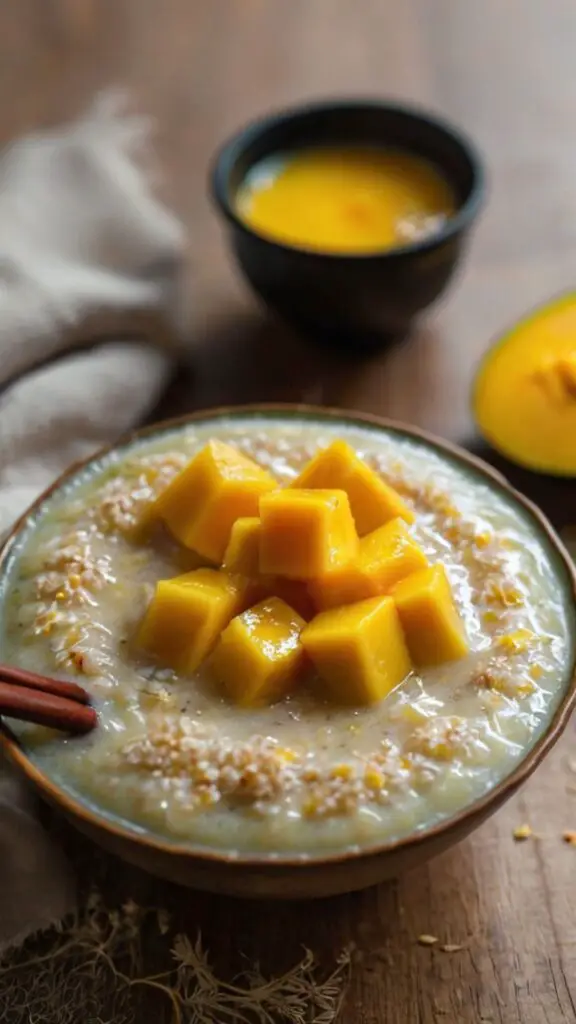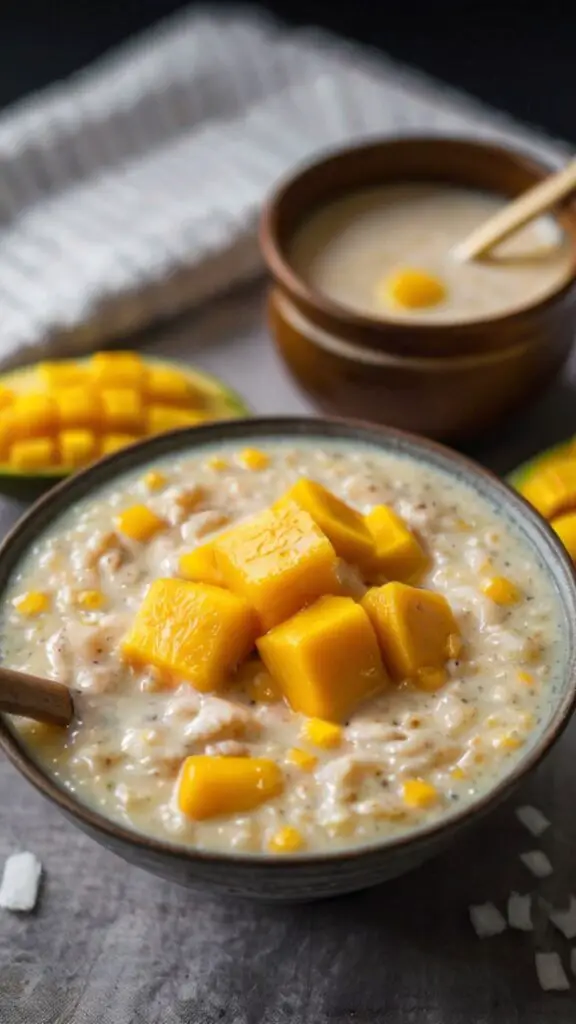How To Make Mango Sago – Culinary Chase
Mango Sago is a sweet, creamy dessert that pairs beautifully with a variety of accompaniments to elevate its tropical flavors. These pairings bring balance and added texture to the dish.
Fresh tropical fruits like kiwi and passion fruit add a tangy contrast that enhances the sweetness of the mango. Toasted coconut flakes provide a delightful crunch and layer of flavor that complements the creamy texture.
For an added crunch, serve with crispy crackers or biscotti, offering a satisfying bite alongside the smooth Mango Sago. Now, let’s dive into making this tropical treat!

I remember the first time I tasted Mango Sago. A friend introduced it to me after a hot day at the beach. The cool, creamy texture paired with the sweetness of ripe mangoes felt like a burst of sunshine on a plate.
It was love at first spoonful. Since then, I have perfected my own recipe, adapting it along the way, making it a staple at gatherings.
Mango Sago is not just a dessert; it’s an experience.
This dish brings out the best of tropical flavors, combining smooth coconut with the lusciousness of ripe mangoes and the fun of tapioca pearls. It’s ideal for summer, dinner parties, or simply a sweet treat after a long day.
So, grab your spoons, and let’s whip up this delightful dessert!
Why This Recipe Works
1. Fresh, Quality Ingredients
This recipe calls for fully ripe Alphonso mangoes. Their sweetness and juiciness are unmatched. The creamy coconut milk enhances the dessert’s richness while keeping it light.
2. Balance of Textures
The smoothness of the coconut milk and the softness of the mango blend beautifully with the chewy texture of tapioca pearls. This contrasts creates a delicious bite, keeping you coming back for more.
3. Simplicity
The steps are straightforward. You don’t need advanced cooking skills to whip this up. With just a handful of ingredients and simple instructions, anyone can conquer this recipe.
4. Versatility
Whether you serve it alone or paired with fresh fruits, this dessert easily adapts. You can even adjust sweetness according to your taste, making it perfect for everyone at your table.
You will also like the following Dessert recipes!
How Does It Taste Like?
Mango Sago is a tropical explosion in your mouth. Imagine velvety coconut mixed with radiant mango sweetness.
The dish is subtly sweet with a hint of saltiness that enhances the flavor profile. Each spoonful reveals the chewy tapioca pearls, adding an unexpected touch. You’ll find yourself lost in its creamy texture and fragrant notes, making it a delightful treat for your taste buds.
What Sets This Recipe Apart from Other Mango Sago Variations?
What makes my Mango Sago special? It’s the balance achieved. While many recipes go heavy on sweetness, I take a lighter approach by incorporating maple syrup sparingly.
The vanilla essence complements the mango flavor, allowing it to shine without being overwhelmed. Plus, the use of creamy condensed milk (but not too much) ensures each step feels indulgent without being cloying.
The Ingredients
Here’s a detailed look at what you’ll need:
3 fully ripe Alphonso mangoes
1 tablespoon maple syrup
200 ml pure coconut milk (unsweetened)
1/2 teaspoon natural vanilla essence
60 ml creamy condensed milk
1/4 teaspoon sea salt
1/2 cup mini pearl tapioca (uncooked)

Instructions
Step 1: Prepare the Tapioca Pearls
Start by cooking the tapioca pearls. You’ll want to follow the package instructions. Usually, this involves boiling them in water until they turn translucent, which takes about 15-20 minutes. Don’t forget to stir occasionally to prevent sticking.
Step 2: Chop the Mangoes
While the tapioca pearls are cooking, peel and chop the mangoes into small cubes. Use a sharp knife for clean cuts. You can reserve some to garnish the final dessert!
Step 3: Blend the Mango Mixture
In a blender, combine the chopped mangoes, coconut milk, maple syrup, and vanilla essence. Blend until smooth. This mixture should be rich and creamy—don’t rush this step. Taste it and adjust sweetness as needed.
Step 4: Combine
Once the tapioca pearls are cooked, drain them and let them cool. Now, in a mixing bowl, combine the tapioca pearls with the mango mixture. Stir gently to incorporate, ensuring the pearls and mango cream are well mixed.
Step 5: Chill
Cover the bowl and place it in the refrigerator for at least an hour. This allows the flavors to meld and the dessert to chill, making it refreshing when served.
Step 6: Serve
Once chilled, serve the Mango Sago in cups or bowls. Top with extra mango cubes and a sprinkle of toasted coconut flakes for a little crunch!
Notes
Use Ripe Fruit: Ripe mangoes are key. They should yield slightly to pressure and have a sweet aroma.
Adjust Sweetness: If you prefer a sweeter dessert, feel free to add more maple syrup.
Tapioca Timing: Overcooking tapioca can lead to mushiness. Keep a close eye on the time.
Garnish Creatively: Try topping with fresh mint or a squeeze of lime for an unexpected twist.
Make Ahead: You can prepare it a day in advance. The flavors get even better with time!
Nutrition Information
How To Make Mango Sago Nutrition Facts
How Do You Store Mango Sago?
Store leftovers in an airtight container in the refrigerator for up to 3 days. The tapioca pearls will continue to soak up the liquid, so if you notice them getting too thick, add a splash of coconut milk before serving again.

Sides for Mango Sago
Sago is delightful on its own, but here are a few companions that enhance your dessert experience:
1. Fruit Skewers
Add a fresh dimension with skewers of kiwi, strawberries, and pineapple. Their vibrant colors and tangy flavors contrast beautifully with Mango Sago.
2. Coconut Macaroons
These chewy treats echo the coconut flavor in the dessert and provide a satisfying crunch, making it a harmonious pairing.
3. Sorbet
A scoop of tropical sorbet, like lime or passion fruit, adds a cool, refreshing note alongside the creamy Mango Sago.
What Alternatives Can You Use for the Ingredients?
If you’re missing some ingredients, don’t fret. Here are some alternatives:
1. Frozen Mango
If fresh mangoes are out of season, frozen mango works well. Just thaw and blend until smooth.
2. Almond Milk
For a nutty flavor, use unsweetened almond milk in place of coconut milk. It’ll change the taste slightly, but it’s still delicious.
3. Honey or Agave Nectar
You can swap maple syrup for honey or agave nectar if you don’t have maple syrup on hand. Just remember to adjust the quantity based on sweetness preferences.
4. Sugar Pearls
If you don’t have tapioca pearls, try using gluten-free chia seeds. They will create a slightly different texture but still yield a pleasant experience.

How To Make Mango Sago
Equipment
- Blender
Ingredients
- 3 fully ripe Alphonso mangoes
- 1 tablespoon maple syrup
- 200 ml pure coconut milk unsweetened
- 1/2 teaspoon natural vanilla essence
- 60 ml creamy condensed milk
- 1/4 teaspoon sea salt
- 1/2 cup mini pearl tapioca uncooked
Instructions
Step 1: Prepare the Tapioca Pearls
- Start by cooking the tapioca pearls. You’ll want to follow the package instructions. Usually, this involves boiling them in water until they turn translucent, which takes about 15-20 minutes. Don’t forget to stir occasionally to prevent sticking.
Step 2: Chop the Mangoes
- While the tapioca pearls are cooking, peel and chop the mangoes into small cubes. Use a sharp knife for clean cuts. You can reserve some to garnish the final dessert!
Step 3: Blend the Mango Mixture
- In a blender, combine the chopped mangoes, coconut milk, maple syrup, and vanilla essence. Blend until smooth. This mixture should be rich and creamy—don’t rush this step. Taste it and adjust sweetness as needed.
Step 4: Combine
- Once the tapioca pearls are cooked, drain them and let them cool. Now, in a mixing bowl, combine the tapioca pearls with the mango mixture. Stir gently to incorporate, ensuring the pearls and mango cream are well mixed.
Step 5: Chill
- Cover the bowl and place it in the refrigerator for at least an hour. This allows the flavors to meld and the dessert to chill, making it refreshing when served.
Step 6: Serve
- Once chilled, serve the Mango Sago in cups or bowls. Top with extra mango cubes and a sprinkle of toasted coconut flakes for a little crunch!
Notes
- Use Ripe Fruit: Ripe mangoes are key. They should yield slightly to pressure and have a sweet aroma.
- Adjust Sweetness: If you prefer a sweeter dessert, feel free to add more maple syrup.
- Tapioca Timing: Overcooking tapioca can lead to mushiness. Keep a close eye on the time.
- Garnish Creatively: Try topping with fresh mint or a squeeze of lime for an unexpected twist.
- Make Ahead: You can prepare it a day in advance. The flavors get even better with time!
Nutrition
Frequently Asked Questions
1. Can I make Mango Sago vegan?
Absolutely! Just use maple syrup and omit the condensed milk, or replace it with a dairy-free condensed milk alternative.
2. What if I don’t have tapioca pearls?
You can substitute with small sago pearls or use chia seeds as mentioned earlier. They will offer a tasty variation.
3. How long can I keep Mango Sago?
Stored well, it can stay fresh in the fridge for about 3 days. Just watch the tapioca texture.
4. Can I add other fruits?
Yes! Consider adding fruits like strawberries or kiwi cubes for a colorful twist. Just remember to keep the flavor balance.
Conclusion
Mango Sago is a tropical treasure that’s as refreshing as it is delicious. With its creamy texture and sweet mango goodness, it’s a dessert everyone will love. Perfect for warm days, gatherings, or simply treating yourself, this dish is bound to brighten your day.
The culinary journey of Mango Sago can become a family tradition. Each scoop is a reminder of sunny days and joyful moments shared around the table.
So, go ahead and create your delightful Mango Sago. It’s more than just dessert; it’s an experience you’ll crave again and again! Happy cooking!
